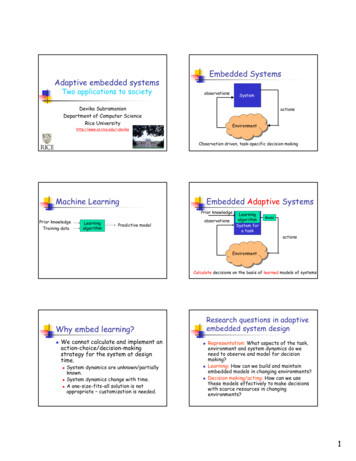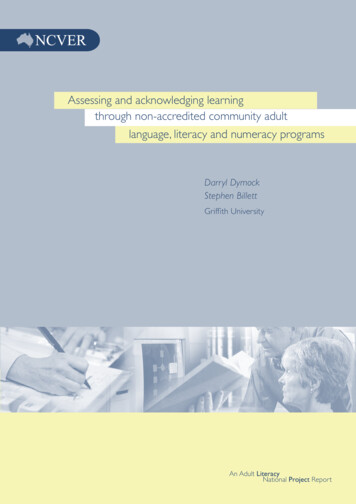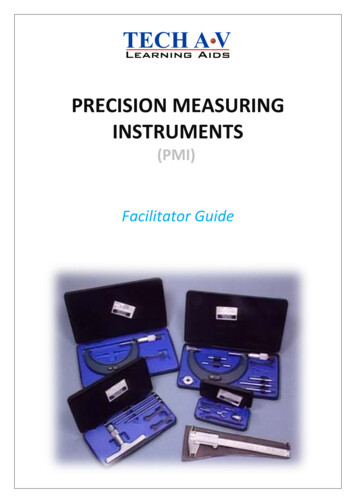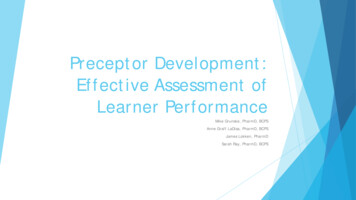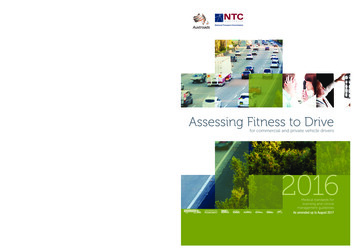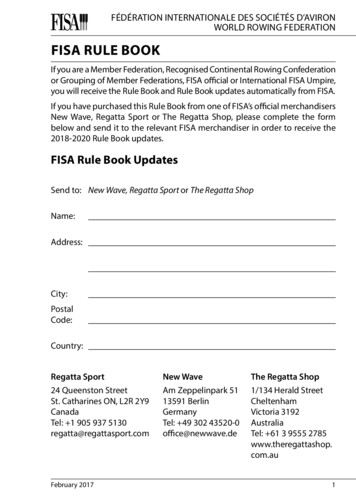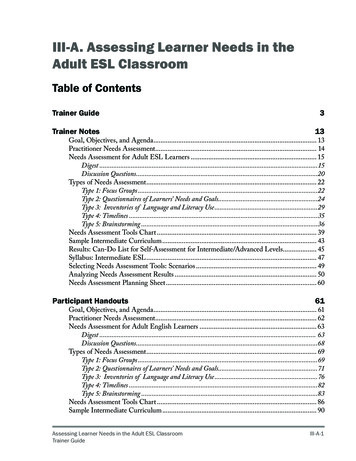
Transcription
III-A. Assessing Learner Needs in theAdult ESL ClassroomTable of ContentsTrainer Guide3Trainer Notes13Participant Handouts61Goal, Objectives, and Agenda. 13Practitioner Needs Assessment. 14Needs Assessment for Adult ESL Learners. 15Digest.15Discussion Questions.20Types of Needs Assessment. 22Type 1: Focus Groups.22Type 2: Questionnaires of Learners’ Needs and Goals.24Type 3: Inventories of Language and Literacy Use.29Type 4: Timelines.35Type 5: Brainstorming.36Needs Assessment Tools Chart. 39Sample Intermediate Curriculum. 43Results: Can-Do List for Self-Assessment for Intermediate/Advanced Levels. 45Syllabus: Intermediate ESL. 47Selecting Needs Assessment Tools: Scenarios. 49Analyzing Needs Assessment Results. 50Needs Assessment Planning Sheet. 60Goal, Objectives, and Agenda. 61Practitioner Needs Assessment. 62Needs Assessment for Adult English Learners. 63Digest. 63Discussion Questions.68Types of Needs Assessment. 69Type 1: Focus Groups.69Type 2: Questionnaires of Learners’ Needs and Goals.71Type 3: Inventories of Language and Literacy Use.76Type 4: Timelines.82Type 5: Brainstorming.83Needs Assessment Tools Chart. 86Sample Intermediate Curriculum. 90Assessing Learner Needs in the Adult ESL ClassroomTrainer GuideIII-A-1
Syllabus: Intermediate ESL. 92Selecting Needs Assessment Tools: Scenarios. 94Analyzing Needs Assessment Results. 95Needs Assessment Planning Sheet. 104Workshop Evaluation. 105III-A-2Assessing Learner Needs in the Adult ESL ClassroomTrainer Guide
The CAELA Guide for Adult ESL TrainersAssessing Learner Needs in the AdultESL ClassroomThis workshop module contains detailed instructions and all of the materials necessary to conduct a training session on assessing learner needs in the adult ESL classroom. The module hasthree components:44 Trainer Guide44 Trainer Notes44 Participant HandoutsThe Trainer Guide is the trainer’s script for the training session. It contains step-by-step instructions for presenting the workshop. It begins with an introduction that states the rationale andpurpose of the workshop. It also gives the goal and objectives of the workshop, the workshopagenda, an overview of workshop sections with the amount of time to be spent on each section,trainer preparation instructions, and materials needed. The introduction is followed by detailedsequential instructions for conducting each section of the workshop.The introduction to each section states the purpose of the activities and the timing of that section. It is followed by a two-column table with instructions for each activity in the first column(Action) and the materials needed in the second column (Materials). Hard copies of all of thematerials needed (with the exception of non-CAELA publications) are provided in the TrainerNotes or the Participant Handouts. Materials are listed by title followed by the page number onwhich they can be found and TN (indicating that it can be found in the Trainer Notes) or PH(indicating that it can be found in the Participant Handouts). Ordering information for nonCAELA publications is given in the workshop introduction. Materials that need to be made intotransparencies for use with an overhead projector or PowerPoint slides are marked “Transparencyor PowerPoint Slide.” You will need to prepare them before the training session.The Trainer Notes accompanies the script of the Trainer Guide. It includes copies of all theparticipant handouts, answer keys to participant activities, transparencies or PowerPoint slides tobe made, and other supplemental handouts if appropriate. The contents of the Trainer Notes areorganized in the order they are needed in the session, and the place they will be used is indicatedin the Materials column in this Trainer Guide.The Participant Handouts contains all the information and activity sheets that participants needto participate in the session and will take with them when they leave. The contents are alsoorganized in the order they will be used in the session. Make a copy of the handouts for eachparticipant.Assessing Learner Needs in the Adult ESL ClassroomTrainer GuideIII-A-3
The CAELA Guide for Adult ESL TrainersAssessing Learner Needs in the AdultESL ClassroomIntroduction to the module: The effective assessment of adult English language learners’ needs,goals, and interests is integral to developing curricula and classroom instruction that hold theattention of the learners. Although learners come to class for a variety of reasons, they usually havespecific learning goals and needs. Learners are more likely to continue coming to class if theirneeds are being met. This workshop module includes many examples of needs assessments. Theseare examples that can be selected and adapted depending on learners’ language and literacy levels.The following Trainer Guide and workshop materials will assist you in conducting a workshop onhow practitioners can assess learner needs to determine class content and instructional focus.Target audience for this workshop: Adult ESL instructors, program administrators, and program coordinatorsGoal of the workshop: To establish the purpose of needs assessment and activate participants’prior knowledge about needs assessment in ESL classroomsWorkshop objectives for participants: At the end of the workshop, participants should be able to44 Identify uses of needs assessment44 Select appropriate assessment tools for the level of their class and the purpose of theneeds assessment44 Analyze needs assessment results to determine class content and instructional needs44 Develop needs assessments for their own classesLength of workshop: 2 to 2½ hours for the basic workshopThe workshop components are as followsPart 1. Introductions and Warm-Up25 minutesPart 2. Presentation: Purposes and Types ofNeeds Assessment50 minutesPart 3. Practice: Developing and InterpretingNeeds Assessment Activities40 minutesPart 4. Application: Planning NeedsAssessment20 minutesPart 5. Wrap-Up and Evaluation15 minutesTotal projected length of workshop150 minutes (2 hours and 30 minutes)**This does not include a break. It is recommended that a 10-minute break be given halfway through the workshop.III-A-4Assessing Learner Needs in the Adult ESL ClassroomTrainer Guide
The CAELA Guide for Adult ESL TrainersMaterials needed for the workshop:44 Assessing Learner Needs: Trainer Guide44 Assessing Learner Needs: Trainer Notes (make transparencies or PowerPoint slides asindicated in the Trainer Guide)44 Assessing Learner Needs: Participant HandoutsNote: In the Trainer Guide, materials to be found in the Trainer Notes are indicated by TN, followed by the page number; materials to befound in the Participant Handouts are indicated by PH, followed by the page number.Assessing Learner Needs in the Adult ESL ClassroomTrainer GuideIII-A-5
The CAELA Guide for Adult ESL Trainers1. Introductions and Warm-UpPurposes:44 To establish the purpose of the training44 To establish the purpose of needs assessment44 To review objectives and agenda for the training44 To activate prior knowledge about needs assessment in ESL classroomsTime: 25 minutesActionsMaterials1. Introductions/Warm-Up (10 minutes) Introduce yourself and the workshop purpose. If participants do not know each other, add a short activityhere to give them the opportunity to introduce themselves.2. Practitioner needs assessment (10 minutes) Have participants work in pairs. Have participants take out the Practitioner NeedsAssessment handout and instruct them to interview eachother using the given questions. They should write down thekey points of their partner’s responses, as they will return tothis activity later.Practitioner NeedsAssessment (TN p. 14,PH p. 62) When participants have finished interviewing each other,review answers with the whole group. Ask participants whatinteresting things they learned in their interviews. Elicit theirexpectations for the training, and record their answers on aflip chart.3. Review of session agenda and objectives (5 minutes) Point out which objectives match participant expectationsand explain how you will handle expectations not coveredin the workshop (e.g., talk privately at break time, suggestresources).III-A-6Assessing Learner Needs:Goal, Objectives, and Agenda(TN p. 13, PH p. 61)Assessing Learner Needs in the Adult ESL ClassroomTrainer Guide
The CAELA Guide for Adult ESL Trainers2. Presentation: Purposes and Types of NeedsAssessmentPurposes:44 To present the purposes and types of needs assessments44 To present information on how to implement instructional steps based on the results ofa needs assessmentTime: 50 minutesActions1. Establish the purpose of needs assessment (20 minutes) Divide participants into groups of four. Explain that each person in the group will read one section of thedigest and then write down his/her answers to the correspondingdiscussion questions. When everyone is finished reading and answering their questions,group members will share their answers with the rest of their group. When the activity is finished, everyone should have answers to thediscussion questions for all four sections of the digest. Quickly review answers with the whole group.2. Discuss the types of needs assessment (20 minutes) Divide participants into five groups of three or four. Assign eachgroup one type of needs assessment from the participant handouts.If there are more than five groups, some groups will have to work onthe same type of needs assessment. Within each group, participants will read the description andexamples and answer discussion questions as a group. Tellparticipants that these are examples that can be selected andadapted depending on learners’ language and literacy levels. When all groups have finished their discussion questions, each groupwill present its type of needs assessment to the whole group. Groupsshould describe their needs assessment activity and discuss theiranswers to the discussion questions. After all groups have presented, have participants take out theNeeds Assessment Tools Chart. Give them 2 to 3 minutes to look itover. Answer any questions.Assessing Learner Needs in the Adult ESL ClassroomTrainer GuideMaterialsDigest: NeedsAssessment for AdultESL Learners(TN pp. 15–19,PH pp. 63–67)Needs Assessmentfor Adult ESL LearnersDigest DiscussionQuestions(TN p. 20–21,PH p. 68)Types of NeedsAssessments(TN pp. 22–38,PH pp. 69–85)Needs AssessmentTools Chart(TN pp. 39–42,PH pp. 86–89)III-A-7
The CAELA Guide for Adult ESL TrainersActionsMaterials3. Examine ways to use the results of needs assessment in planning aprogram, curriculum, and instructional steps (10 minutes) Have participants take out the sample curriculum and take 2 to 3minutes to look it over. Show participants the overhead transparency or PowerPoint slideindicating the results of the sample needs assessment activity. Using the transparency or PowerPoint slide, conduct an analysis ofthe needs assessment results with the whole group. Circle topicsthat large numbers of participants marked “a little difficult” or“very difficult.” Point out that certain topics (employment, banking,housing, health/emergencies, school, and directions) are toppriorities. Post office and phone numbers are secondary. Have participants take out the sample syllabus based on thecurriculum and needs assessment. Explain that this represents oneway of organizing the 10-week class session based on the abovesample needs assessment results. Ask participants how they mighthave structured their 10-week session differently. Ask them toexplain the reasons for a particular structure.III-A-8Sample IntermediateCurriculum(TN pp. 43–44,PH pp. 90–91)Transparency orPowerPoint slide:Needs AssessmentResults(TN pp. 45–46)Syllabus: IntermediateESL (TN p. 47–48,PH p. 92–93)Assessing Learner Needs in the Adult ESL ClassroomTrainer Guide
The CAELA Guide for Adult ESL Trainers3. Practice: Developing and Interpreting NeedsAssessment ActivitiesPurposes:44 To apply the concepts learned in the presentation of new material44 To increase skills in planning and analyzing needs assessmentObjectives covered:44 Select appropriate tools for the level of their class and the purpose of the needsassessment44 Analyze needs assessment results to determine class content and instructional focusTime: 40 minutesActionsMaterials1. Analysis of needs assessment scenarios (20 minutes) Have participants take out the worksheet Selecting NeedsAssessment Tools: Scenarios. Present the example scenario to thewhole group. Have the whole group discuss which needs assessment tools wouldbe appropriate for the given situation, how best to set up the needsassessment, and what information would be learned from the needsassessment.Selecting NeedsAssessment Tools:Scenarios (TN p. 49,PH p. 94) Divide participants into small groups. In groups, participants will work on the five scenarios in theworksheet to determine which type of needs assessment to useand discuss why they chose that tool, how they would set it up, andwhat they would hope to learn from that particular type of needsassessment. When groups are finished, briefly review the scenarios and decisionsbased on the scenarios, as a whole group.Assessing Learner Needs in the Adult ESL ClassroomTrainer GuideIII-A-9
The CAELA Guide for Adult ESL TrainersActionsMaterials2. Analysis of needs assessment results (20 minutes) Have participants take out the Analyzing Needs Assessment Results Analyzing Needsworksheets. Go over the example as a whole group and discussAssessment Resultswhich instructional steps would be best to take based on the results. (TN pp. 50–59, Divide participants into groups of three or four. If there are more than PH pp. 95–103)five groups, some groups will have to work on the same set of needsassessment results. Assign a set of needs assessment results to each group. In theirgroups, participants will analyze the sample results by answeringthe guiding questions provided and coming up with appropriateinstructional steps to take. When all the groups are finished, they will present their sampleresults and instructional steps to the whole group.III-A-10Assessing Learner Needs in the Adult ESL ClassroomTrainer Guide
The CAELA Guide for Adult ESL Trainers4. Application: Planning Needs AssessmentPurpose:44 To discuss application activitiesObjective covered:44 Develop needs assessments for their own classTime: 20 minutesActionsMaterialsApplication Have participants take out the Needs Assessment Planning Sheet.Needs AssessmentPlanning Sheet Discuss the worksheet with participants. Have one or twoparticipants share what their next steps will be in their classrooms or (TN p. 60, PH p. 104)programs.5. Wrap-Up and EvaluationPurpose:44 To reflect on the trainingTime: 15 minutesActionsMaterialsReflection on practitioner needs assessment Return to the Practitioner Needs Assessment from the warm-up.Practitioner Needs Have participants discuss with their partners how they will use needs Assessmentassessment in their classrooms. Have participants focus on the following questions: What has thistraining confirmed for you about needs assessment? What changeswill you make based on this training? What information do you stillneed? Discuss any unmet expectations of the training. Ask participants to complete the Workshop Evaluation form.Assessing Learner Needs in the Adult ESL ClassroomTrainer GuideWorkshop EvaluationForm (PH, p. 105)III-A-11
Notes
Assessing Learner Needs in the AdultESL ClassroomGoal, Objectives, and AgendaGoal:To establish the purpose of needs assessment and activate participants’ prior knowledge aboutneeds assessment in ESL classroomsObjectives:At the end of the workshop, participants should be able to44 Identify the uses of needs assessment44 Select appropriate tools for the level of their class and the purpose of theneeds assessment44 Analyze needs assessment results to determine class content and instructional needs44 Develop needs assessments for their own classAgenda:I.Introductions and Warm-UpII.Presentation: Purposes and types of needs assessmentIII. Practice: Developing and interpreting needs assessment activitiesIV.Application: Planning needs assessmentV.Wrap-Up and EvaluationAssessing Learner Needs in the Adult ESL ClassroomTrainer NotesIII-A-13
The CAELA Guide for Adult ESL TrainersPractitioner Needs AssessmentAsk your partner the following questions:1. What type of program do you work in? What is your role? (administrator, teacher, etc.)2. What types of needs assessment do you use in your program? In your classroom?3. How do you use the results?4. What further information would you like regarding needs assessment?III-A-14Assessing Learner Needs in the Adult ESL ClassroomTrainer Notes
The CAELA Guide for Adult ESL TrainersNeeds Assessment for Adult ESL LearnersKathleen Santopietro Weddel, Colorado Department of EducationCarol Van Duzer, National Center for ESL Literacy EducationMay 1997Assessment of literacy needs from the learner’s perspective is an important part of an instructional program. Learners come to adult English as a second language (ESL) literacy programs fordiverse reasons. Although they may say they just want to “learn English,” they frequently havevery specific learning goals and needs: for example, to be able to read to their children, to get ajob, or to become a citizen. If their needs are not met, they are more likely to drop out than tovoice their dissatisfaction (Grant & Shank, 1993). The needs assessment process can be used asthe basis for developing curricula and classroom practice that are responsive to these needs.Although learner needs assessment encompasses both what learners know and can do (learnerproficiencies) and what they want to learn and be able to do, this digest focuses on ways to determine what learners want or believe they need to learn. Many of the activities described can alsoinclude or lead to assessment of proficiencies, and many of the sources cited include both types ofassessment. (See Burt & Keenan, 1995, for a discussion of assessment of what learners know.)What Is Needs Assessment?The word “assess” comes from the Latin term “assidere,” which means to “sit beside.” Processminded and participatory-oriented adult educators “sit beside” learners to learn about their proficiencies and backgrounds, educational goals, and expected outcomes, immersing themselves inthe lives and views of their students (Auerbach, 1994).A needs assessment for use with adult learners of English is a tool that examines, from theperspective of the learner, what kinds of English, native language, and literacy skills the learneralready believes he or she has; the literacy contexts in which the learner lives and works; what thelearner wants and needs to know to function in those contexts; what the learner expects to gainfrom the instructional program; and what might need to be done in the native language or withthe aid of an interpreter. The needs assessment focuses and builds on learners’ accomplishmentsand abilities rather than on deficits, allowing learners to articulate and display what they alreadyknow and can do (Auerbach, 1994; Holt, 1994).Needs assessment is a continual process and takes place throughout the instructional program(Burnaby, 1989; Savage, 1993), thus influencing student placement, materials selection, curriculum design, and teaching approaches (Wrigley & Guth, 1992). As Burnaby (1989) noted, “Thecurriculum content and learning experiences to take place in class should be negotiated betweenlearners, teacher, and coordinator at the beginning of the project and renegotiated regularlyduring the project” (p. 20). At the beginning of the program, needs assessment might be usedto determine appropriate program types and course content; during the program, it assures thatlearner and program goals are being met and allows for necessary program changes; at the end ofthe program, it can be used for assessing progress and planning future directions for the learnersand the program.Assessing Learner Needs in the Adult ESL ClassroomTrainer NotesIII-A-15
The CAELA Guide for Adult ESL TrainersWhy Is Needs Assessment Important?A needs assessment serves a number of purposes:44 It aids administrators, teachers, and tutors with learner placement and in developingmaterials, curricula, skills assessments, teaching approaches, and teacher training.44 It assures a flexible, responsive curriculum rather than a fixed, linear curriculum determined ahead of time by instructors.44 It provides information to the instructor and learner about what the learner brings tothe course (if done at the beginning), what has been accomplished (if done during thecourse), and what the learner wants and needs to know next.Factors that contribute to learner attrition in adult literacy programs include inappropriate placement and instructional materials and approaches that are not relevant to learners’ needs and lives(Brod, 1995). When learners know that educators understand and want to address their needsand interests, they are motivated to continue in a program and to learn.Assessment ToolsNeeds assessments with ESL learners, as well as with those in adult basic education programs,can take a variety of forms, including survey questionnaires on which learners check areas ofinterest or need, open-ended interviews, or informal observations of performance. In order forneeds assessment to be effective, tools and activities should be appropriate for the particularlearner or groups of learners. For example, reading texts in English might be translated into thelearners’ native languages, read aloud by the teacher or an aide (in English or the native language), or represented pictorially. Types of needs assessment tools and activities include:Survey questionnaires. Many types of questionnaires have been designed to determine learners’literacy needs. Frequently they consist of a list of topics, skills, or language and literacy uses. Thelearners indicate what they already know or want to know by checking in the appropriate columnor box, or they may be asked to use a scale to rank the importance of each item. For beginninglearners who do not read English, pictures depicting different literacy contexts (such as using atelephone, buying groceries, driving a car, and using transportation) can be shown, and learnerscan mark the contexts that apply to them. For example, using transportation could be representedby pictures of a bus, a subway, and a taxi. The list of questionnaire items can be prepared ahead oftime by the teacher or generated by the students themselves through class discussion.Learner-compiled inventories of language and literacy use. A more open-ended way to get thesame information that surveys offer is to have learners keep lists of ways they use language andliteracy and to update them periodically (McGrail & Schwartz, 1993).Learner interviews. Interviews with learners, either one-on-one or in small groups, in theirnative language or in English, can provide valuable information about what learners know, whattheir interests are, and the ways they use or hope to use literacy.III-A-16Assessing Learner Needs in the Adult ESL ClassroomTrainer Notes
The CAELA Guide for Adult ESL TrainersReview of reading materials. An instructor can spread out a range of reading materials on thetable (e.g., newspapers, magazines, children’s books, comics, and greeting cards, and ask learnerswhich they would like to read and whether they would like to work in class on any of them. Asimilar activity can be done with different types of writing.Class discussions. Showing pictures of adults in various contexts, the teacher can ask, “Whatliteracy skills does this person want to develop?” and have learners generate a list. The teacher thenasks, “Why do you want to develop literacy skills?” Learners might be more willing to expresstheir desires if they move from the impersonal to the personal in this way (Auerbach, 1994).Personal or dialogue journals. Learners’ journals—where they write freely about theiractivities, experiences, and plans—can be a rich source of information about their literacy needs(Peyton, 1993).Timelines. Learners can prepare their own personal timelines, in writing or pictorially, that indicate major events in their lives as well as future goals. Discussion can then focus on how progresstowards those goals can be met through the class (Santopietro, 1991).Needs Assessment in One Adult Esl ProgramThe Arlington Education and Employment Program (REEP) in Arlington, Virginia periodicallyconducts a program-wide needs assessment to determine the interests and goals of ESL learnersin the community. The director and program coordinators collaborate with community agencies, schools, and employers to identify ways in which the REEP program can prepare learnersfor the economic, civic, and family opportunities available in the community. This information isthen used for program planning purposes, such as developing courses, curricula, and materials,and preparing needs assessment tools. Learner interviews and a placement test assessing generallanguage proficiency are used to place learners in an instructional level. Once they are in theclassroom, learners participate in a continual needs assessment process to plan what they want tolearn and how they want to learn it.In-class needs assessment is most successful when learners understand its purpose and are comfortable with each other. Because of this, the first curriculum unit in every new class is called“Getting Started” (Arlington Education and Employment Program, 1994). It enables learnersto get to know one another through the needs assessment process as they acknowledge sharedconcerns and begin to build a community in the classroom (Van Duzer, 1995). For severaldays, some class time may be spent discussing where they use English, what they do with it,what problems they have encountered, and why they feel they need to improve their languageskills and knowledge. Through this process, both the learners and the teacher become awareof the goals and needs represented in the class. A variety of level-appropriate techniques, likethose mentioned above, are used to come to a consensus on the class instructional plan and todevelop individual learning plans. Learners select from both program-established curricularunits and from their identified needs. The needs assessment process serves as both a learning and information-gathering process as learners use critical thinking, negotiation, and problem-solvingskills to reach this plan.Assessing Learner Needs in the Adult ESL ClassroomTrainer NotesIII-A-17
The CAELA Guide for Adult ESL TrainersOnce the class instructional plan is selected, ways are discussed to meet individual learner needsapart from the w
digest and then write down his/her answers to the corresponding discussion questions. When everyone is finished reading and answering their questions, group members will share their answers with the rest of their group. When the activity is finished, everyone should have answers to the discussion questions for all four sections of the .
